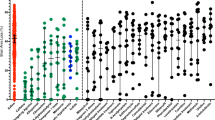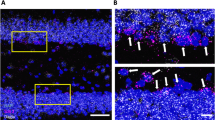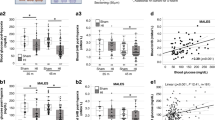Abstract
Background:
The endocannabinoids are emerging as natural brain protective substances that exert potentially beneficial effects in several neurological disorders by virtue of their hypothermic, immunomodulatory, vascular, antioxidant, and antiapoptotic actions. This study was undertaken to assess whether preventing the deactivation of the endocannabinoid 2-arachidonoylglycerol (2-AG) with the monoacylglycerol lipase (MAGL) inhibitor URB602 can provide neuroprotective effects in hypoxia–ischemia (HI)-induced brain injury.
Methods:
URB602 was administered into the right lateral ventricle 30 min before 7-day-old pup rats were subjected to HI. The neuroprotective effect was evaluated on postnatal day (PN) 14 or at adulthood (PN80) using behavioral and histological analyses. Activated caspase-3 expression and propidium iodide labeling were assessed as indexes of apoptotic and necrotic cell death, respectively.
Results:
Pretreatment with URB602 reduced apoptotic and necrotic cell death, as well as the infarct volume measured at PN14. At adulthood, URB602-treated HI animals performed better at the T-maze and the Morris maze, and also showed a significant reduction of brain damage.
Conclusion:
These results demonstrate that a pretreatment with URB602 significantly reduces brain damage and improves functional outcome, indicating that endocannabinoid-degrading enzymes may represent an important target for neuroprotection in neonatal ischemic brain injury.
Similar content being viewed by others
Log in or create a free account to read this content
Gain free access to this article, as well as selected content from this journal and more on nature.com
or
References
Piomelli D . The molecular logic of endocannabinoid signalling. Nat Rev Neurosci 2003;4:873–84.
Galve-Roperh I, Aguado T, Palazuelos J, Guzmán M . Mechanisms of control of neuron survival by the endocannabinoid system. Curr Pharm Des 2008;14:2279–88.
Klein TW, Lane B, Newton CA, Friedman H . The cannabinoid system and cytokine network. Proc Soc Exp Biol Med 2000;225:1–8.
Mechoulam R, Panikashvili D, Shohami E . Cannabinoids and brain injury: therapeutic implications. Trends Mol Med 2002;8:58–61.
Muthian S, Rademacher DJ, Roelke CT, Gross GJ, Hillard CJ . Anandamide content is increased and CB1 cannabinoid receptor blockade is protective during transient, focal cerebral ischemia. Neuroscience 2004;129:743–50.
Degn M, Lambertsen KL, Petersen G, et al. Changes in brain levels of N-acylethanolamines and 2-arachidonoylglycerol in focal cerebral ischemia in mice. J Neurochem 2007;103:1907–16.
Fernández-López D, Martínez-Orgado J, Nuñez E, et al. Characterization of the neuroprotective effect of the cannabinoid agonist WIN-55212 in an in vitro model of hypoxic-ischemic brain damage in newborn rats. Pediatr Res 2006;60:169–73.
Zhang M, Martin BR, Adler MW, Razdan RK, Ganea D, Tuma RF . Modulation of the balance between cannabinoid CB(1) and CB(2) receptor activation during cerebral ischemic/reperfusion injury. Neuroscience 2008;152:753–60.
Pellegrini-Giampietro DE, Mannaioni G, Bagetta G . Post-ischemic brain damage: the endocannabinoid system in the mechanisms of neuronal death. FEBS J 2009;276:2–12.
Zhang M, Martin BR, Adler MW, et al. Modulation of cannabinoid receptor activation as a neuroprotective strategy for EAE and stroke. J Neuroimmune Pharmacol 2009;4:249–59.
Panikashvili D, Simeonidou C, Ben-Shabat S, et al. An endogenous cannabinoid (2-AG) is neuroprotective after brain injury. Nature 2001;413:527–31.
Shen M, Thayer SA . Cannabinoid receptor agonists protect cultured rat hippocampal neurons from excitotoxicity. Mol Pharmacol 1998;54:459–62.
van der Stelt M, Veldhuis WB, Bär PR, Veldink GA, Vliegenthart JF, Nicolay K . Neuroprotection by Delta9-tetrahydrocannabinol, the main active compound in marijuana, against ouabain-induced in vivo excitotoxicity. J Neurosci 2001;21:6475–9.
Fernández-López D, Pazos MR, Tolón RM, et al. The cannabinoid agonist WIN55212 reduces brain damage in an in vivo model of hypoxic-ischemic encephalopathy in newborn rats. Pediatr Res 2007;62:255–60.
Alonso-Alconada D, Alvarez FJ, Alvarez A, et al. The cannabinoid receptor agonist WIN 55,212-2 reduces the initial cerebral damage after hypoxic-ischemic injury in fetal lambs. Brain Res 2010;1362:150–9.
Gaetani S, Dipasquale P, Romano A, et al. The endocannabinoid system as a target for novel anxiolytic and antidepressant drugs. Int Rev Neurobiol 2009;85:57–72.
Landucci E, Scartabelli T, Gerace E, Moroni F, Pellegrini-Giampietro DE . CB1 receptors and post-ischemic brain damage: studies on the toxic and neuroprotective effects of cannabinoids in rat organotypic hippocampal slices. Neuropharmacology 2011;60:674–82.
Carloni S, Carnevali A, Cimino M, Balduini W . Extended role of necrotic cell death after hypoxia-ischemia-induced neurodegeneration in the neonatal rat. Neurobiol Dis 2007;27:354–61.
Balduini W, De Angelis V, Mazzoni E, Cimino M . Long-lasting behavioral alterations following a hypoxic/ischemic brain injury in neonatal rats. Brain Res 2000;859:318–25.
Carloni S, Perrone S, Buonocore G, Longini M, Proietti F, Balduini W . Melatonin protects from the long-term consequences of a neonatal hypoxic-ischemic brain injury in rats. J Pineal Res 2008;44:157–64.
Balduini W, De Angelis V, Mazzoni E, Cimino M . Simvastatin protects against long-lasting behavioral and morphological consequences of neonatal hypoxic/ischemic brain injury. Stroke 2001;32:2185–91.
Schomacher M, Müller HD, Sommer C, Schwab S, Schäbitz WR . Endocannabinoids mediate neuroprotection after transient focal cerebral ischemia. Brain Res 2008;1240:213–20.
Dinh TP, Kathuria S, Piomelli D . RNA interference suggests a primary role for monoacylglycerol lipase in the degradation of the endocannabinoid 2-arachidonoylglycerol. Mol Pharmacol 2004;66:1260–4.
Makara JK, Mor M, Fegley D, et al. Selective inhibition of 2-AG hydrolysis enhances endocannabinoid signaling in hippocampus. Nat Neurosci 2005;8:1139–41.
Hohmann AG, Suplita RL, Bolton NM, et al. An endocannabinoid mechanism for stress-induced analgesia. Nature 2005;435:1108–12.
King AR, Duranti A, Tontini A, et al. URB602 inhibits monoacylglycerol lipase and selectively blocks 2-arachidonoylglycerol degradation in intact brain slices. Chem Biol 2007;14:1357–65.
Comelli F, Giagnoni G, Bettoni I, Colleoni M, Costa B . The inhibition of monoacylglycerol lipase by URB602 showed an anti-inflammatory and anti-nociceptive effect in a murine model of acute inflammation. Br J Pharmacol 2007;152:787–94.
Panikashvili D, Shein NA, Mechoulam R, et al. The endocannabinoid 2-AG protects the blood-brain barrier after closed head injury and inhibits mRNA expression of proinflammatory cytokines. Neurobiol Dis 2006;22:257–64.
Zhang J, Chen C . Endocannabinoid 2-arachidonoylglycerol protects neurons by limiting COX-2 elevation. J Biol Chem 2008;283:22601–11.
Rice JE 3rd, Vannucci RC, Brierley JB . The influence of immaturity on hypoxic-ischemic brain damage in the rat. Ann Neurol 1981;9:131–41.
Tarzia G, Duranti A, Tontini A, et al. Design, synthesis, and structure-activity relationships of alkylcarbamic acid aryl esters, a new class of fatty acid amide hydrolase inhibitors. J Med Chem 2003;46:2352–60.
Acknowledgements
We thank Claudia Scopa for the excellent technical assistance and Kevin Worrell for his helpful hints.
Author information
Authors and Affiliations
Corresponding author
Rights and permissions
About this article
Cite this article
Carloni, S., Alonso-Alconada, D., Girelli, S. et al. Pretreatment with the monoacylglycerol lipase inhibitor URB602 protects from the long-term consequences of neonatal hypoxic–ischemic brain injury in rats. Pediatr Res 72, 400–406 (2012). https://doi.org/10.1038/pr.2012.91
Received:
Accepted:
Published:
Issue date:
DOI: https://doi.org/10.1038/pr.2012.91
This article is cited by
-
Monoacylglycerol Lipase Inhibition Prevents Short-Term Mitochondrial Dysfunction and Oxidative Damage in Rat Brain Synaptosomal/Mitochondrial Fractions and Cortical Slices: Role of Cannabinoid Receptors
Neurotoxicity Research (2023)
-
URB597 Prevents the Short-Term Excitotoxic Cell Damage in Rat Cortical Slices: Role of Cannabinoid 1 Receptors
Neurotoxicity Research (2021)
-
Cannabinoid CB1 and CB2 Receptors, and Monoacylglycerol Lipase Gene Expression Alterations in the Basal Ganglia of Patients with Parkinson's Disease
Neurotherapeutics (2018)
-
Docosahexaenoic Acid Reduces Cerebral Damage and Ameliorates Long-Term Cognitive Impairments Caused by Neonatal Hypoxia–Ischemia in Rats
Molecular Neurobiology (2017)
-
Excess cerebral TNF causing glutamate excitotoxicity rationalizes treatment of neurodegenerative diseases and neurogenic pain by anti-TNF agents
Journal of Neuroinflammation (2016)



